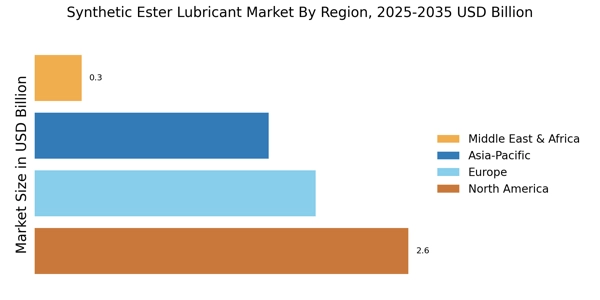The Synthetic Ester Lubricant Market is currently characterized by a dynamic competitive landscape, driven by increasing demand for high-performance lubricants across various industries, including automotive, aerospace, and manufacturing. Key players such as ExxonMobil (US), Castrol (GB), and TotalEnergies (FR) are strategically positioned to leverage their extensive research and development capabilities, focusing on innovation and sustainability. These companies are actively investing in the development of bio-based synthetic esters, which not only enhance performance but also align with global sustainability goals. Their collective strategies are shaping a competitive environment that emphasizes technological advancement and environmental responsibility.
In terms of business tactics, companies are increasingly localizing manufacturing to reduce lead times and optimize supply chains. This approach appears to be particularly effective in a moderately fragmented market, where the presence of numerous players allows for regional specialization. The influence of key players is significant, as they not only set industry standards but also drive market trends through their innovative product offerings and strategic partnerships.
In August 2025, ExxonMobil (US) announced the launch of a new line of synthetic esters designed specifically for electric vehicle applications. This strategic move underscores the company's commitment to adapting to the evolving automotive landscape, where electric vehicles are gaining traction. By focusing on this niche, ExxonMobil positions itself as a leader in a burgeoning segment, potentially capturing a significant share of the market as demand for electric vehicle lubricants increases.
Similarly, in July 2025, Castrol (GB) expanded its partnership with a leading automotive manufacturer to co-develop advanced synthetic lubricants tailored for high-performance engines. This collaboration not only enhances Castrol's product portfolio but also reinforces its reputation as a trusted partner in the automotive sector. The strategic importance of such partnerships lies in their ability to foster innovation and accelerate product development cycles, thereby maintaining a competitive edge.
In September 2025, TotalEnergies (FR) unveiled a new sustainability initiative aimed at reducing the carbon footprint of its synthetic ester production processes. This initiative reflects a broader industry trend towards sustainability, as companies recognize the importance of environmental stewardship in their operations. By prioritizing sustainable practices, TotalEnergies not only meets regulatory requirements but also appeals to environmentally conscious consumers, thereby enhancing its market position.
As of October 2025, the competitive trends in the Synthetic Ester Lubricant Market are increasingly defined by digitalization, sustainability, and the integration of artificial intelligence in product development. Strategic alliances are becoming more prevalent, as companies seek to combine resources and expertise to drive innovation. Looking ahead, competitive differentiation is likely to evolve from traditional price-based competition to a focus on technological advancements, supply chain reliability, and sustainable practices, positioning companies that embrace these trends for long-term success.


















Leave a Comment